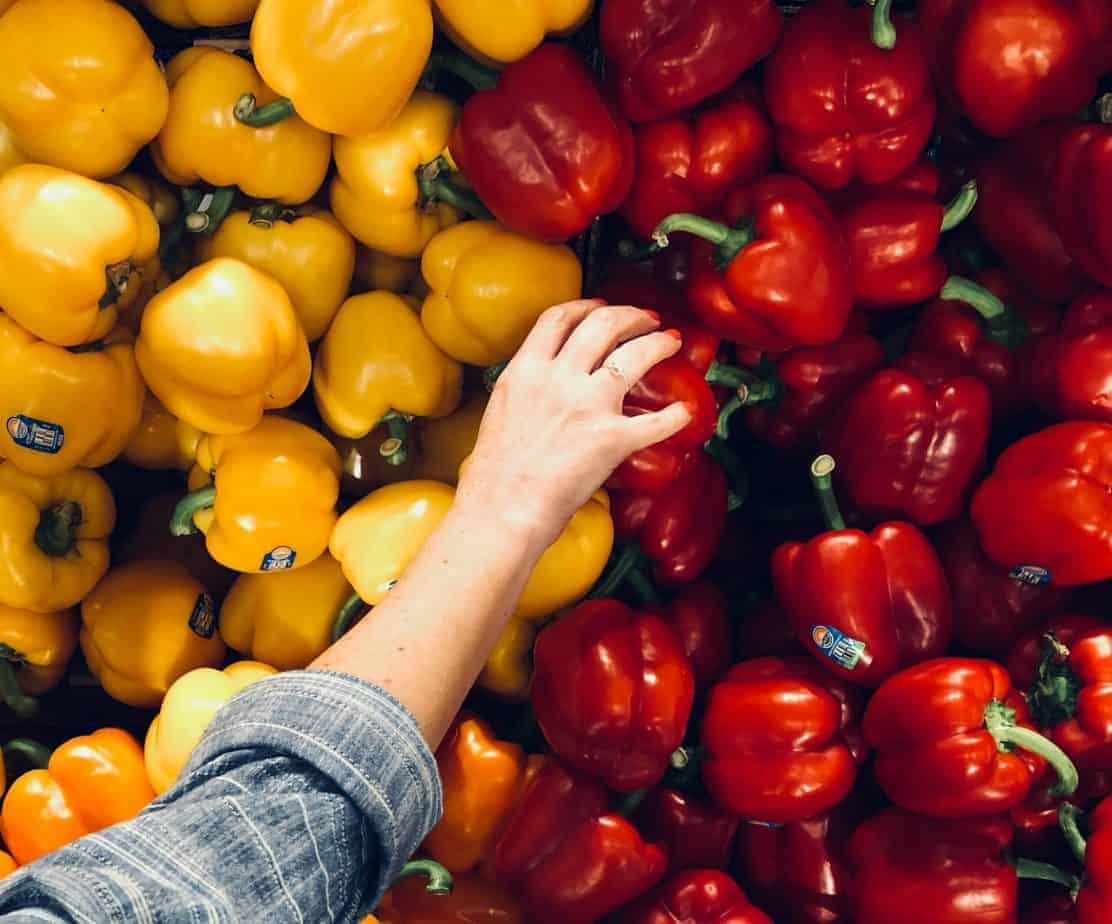


Find foods you can eat.
How to Start Grocery Shopping Like a Dietitian
Published on November 17, 2021The key to eating nutritious meals (and navigating dietary restrictions) is planning ahead. Figuring out what to buy at the grocery store can seem overwhelming and time consuming, but it doesn’t have to be! As both a registered dietitian nutritionist and someone with dietary restrictions, I’ve come up with a few tips and tricks over the years to help simplify things. Here, I compiled my top grocery shopping tips and break down the steps I take before heading to the store in order to efficiently use my time, minimize food waste, save money, and help figure out what to cook each week.
Before you go to the store:
Take inventory of what you already have
My grocery shopping process always begins in my kitchen. If I don’t take notice of what I already have in my refrigerator, freezer, and pantry, I’ll forget about items that I need to use up before they spoil, or I may end up unnecessarily buying duplicates of some items. Taking a brief inventory before you head to the store will help you save money, minimize food waste, and come up with meal ideas.
Brainstorm meal ideas
After I know what I already have, I brainstorm meal ideas using these items, especially fresh foods that may end up getting thrown out unless I use them within the next few days. If I have a leftover jar of open tomato sauce, for example, I’ll think of dishes that incorporate tomato sauce.
I try to come up with 2-3 dinner ideas before I go to the store. Looking at food blogs, Instagram accounts dedicated to easy, healthy meals, and flipping through cookbooks all help to provide meal inspiration. Anytime I find a recipe that looks good, I’ll save it in my phone so that I remember when I’m creating my shopping list. If you have dietary restrictions, it can be helpful to seek out food recipe blogs dedicated to your specific restrictions.
Make a shopping list
Once I’ve decided what I’ll cook that week, it’s time to make my list, taking into account what I already have.
Tips for when you’re at the store:
Avoid grocery shopping while hungry
We’ve all been there—we go grocery shopping while ravenously hungry and come home with half the store. We then get home and realize we could have done without many of the items we purchased. While we may be mad at ourselves for this, it’s not entirely our fault! When we’re overly hungry, our body is programmed to crave foods that provide us with quick energy. Often, this means we’re drawn to sugary foods or other refined carbohydrates like chips, crackers, and snack foods that will quickly bring our blood sugar back up. Unfortunately, these foods tend to be heavily processed and lacking in nutritional value, therefore, we should avoid filling our cart with these items as best we can. If you go to the store after you’ve eaten a meal, you’ll be more likely to make rational food decisions and stick to your grocery list, rather than making impulse purchases.
Get into the habit of reading food labels
Whether you have dietary restrictions, or are just looking to eat healthfully, reading food labels is critical. Reading food labels can help you make food purchasing decisions to select items that best support your health. From bread, yogurt, nut butters, milk alternatives, cereal, salad dressings, sauces, and more, there are so many different brands and varieties of foods to choose from that it can feel overwhelming. When in doubt, it’s generally best to select the option with fewer ingredients, or with ingredients that are mostly recognizable to you. If the ingredient list looks overwhelming, the product is likely very processed. Depending on your needs and health goals, you may want to focus in on specific things when looking at food labels. For example, if you have diabetes, you’ll want to focus on selecting foods that are higher in fiber and don’t contain much added sugar, whereas if you have Celiac disease, you’ll need to check food labels for hidden sources of gluten and the potential for cross-contamination. The Fig mobile app (in beta) is a helpful resource that can assist you in making the best food choices for your specific needs.
Stock up on freezer staples
Frozen foods get a bad rap, but they can be highly nutritious and are very convenient. Frozen produce is frozen at peak ripeness which preserves its nutritional value, so it’s just as nutritious as fresh. Frozen produce is also generally more cost effective than fresh produce and can last for months in your freezer. In addition to produce, I stock my freezer with proteins like fish, chicken, and ground turkey, which I’ll add to lunches and dinners. During the week, I can then easily defrost and prepare my protein without having to run to the store again.
Utilize the bulk bins when shopping for dried goods
If your grocery store has bulk bins, stock up on dried goods like whole grains, dried beans, nuts, seeds, and flours here. They’re often less expensive in the bulk bins and if you only need a small amount of something for a recipe, you can take exactly what you need without having to buy a full container that may go to waste.
Focus on the perimeter of the store, but don’t neglect the inner aisles
You may have heard that you should only shop around the perimeter of the grocery store. The truth is, while many nutritious foods like fresh produce, proteins, and dairy products are generally around the perimeter, if you ignore the inner aisles, you may be missing out on some other nutritious foods. Nuts, seeds, nut and seed butters, beans, whole grains, olive oil, and dried spices are all minimally processed, whole foods usually found in the inner aisles of the store.
Be open to trying new foods
It’s easy to stick to the same few foods that we like and know how to prepare, but the more variety we have in our diet, the better. Incorporating a diverse array of different foods and food groups helps to ensure that we’re getting a variety of nutrients. Additionally, our good gut bacteria like variety and eating a wide assortment of plant-based foods is associated with a healthier, more robust gut microbiome. If a fruit or vegetable that you haven’t tried before looks good to you, add it to your cart. You can always look up how to prepare it online when you get home.
Shopping local:
Visit your local farmer’s market to try unique varieties of produce, get recipe inspiration, and support local agriculture
I visit my local farmer’s market whenever I have the opportunity. Farmer’s markets often have unique items that you won’t find at conventional grocery stores and can help push you to try new things. If something catches your eye but you aren’t sure how to prepare it, don’t hesitate to ask the vendor for their recommendations. They’re usually happy to provide suggestions—in fact, I’ve gotten some of my best recipe ideas from talking to my local farmers! By supporting local agriculture, you’ll be cutting back on your carbon footprint by minimizing “food miles,” plus locally grown foods are often fresher and therefore more nutritious.
Items that are frequently in my cart:
We all have different dietary needs, restrictions, and food preferences, therefore my shopping cart may look different from yours, however, this list can help to provide some general ideas to get you started.
Frozen vegetables and berries
Some of my favorites include mushrooms to add to omelets, broccoli to throw into stir fry dishes or roast as a side dish, and riced cauliflower, which I add to smoothies. It may sound like an odd smoothie ingredient, but riced cauliflower gives smoothies a thick, frozen texture and adds fiber and micronutrients. I promise you won’t taste it as long as you add enough fruit! And speaking of smoothies, I always have a bag of frozen blueberries in my freezer to add for sweetness. I try to purchase organic produce whenever possible, particularly when shopping for fruits and vegetables with a very thin skin (like berries). Although organic agricultural practices are not always perfect, organic produce often contains fewer pesticide residues compared to conventional. When in doubt, I refer to the Environmental Working Group (EWG)’s “Dirty Dozen” list. The EWG is a non-profit advocacy group that ranks pesticide contamination of commonly consumed fruits and vegetables each year. Foods that make the Dirty Dozen list are found to contain the highest levels of pesticide residues when purchased from conventional sources. Produce on the “Clean Fifteen” list was found to contain the lowest levels of pesticide residues, so for these items, I don’t worry about buying organic.
Leafy greens
Leafy greens are one of the most nutrient-dense foods out there. I like having 2 varieties on hand for salads, to add to cooked dishes, and to blend into smoothies for added nutrition. Kale, arugula, and romaine lettuce are frequently in my shopping cart. As with berries, I aim to purchase organic leafy greens whenever possible because leafy greens including kale, collard greens, mustard greens, and spinach are on the Dirty Dozen list.
Fresh fruit
I often stock up on fresh berries (especially when they’re in season) to have with breakfast, and depending on the season, I’ll buy a few apples, peaches, plums, nectarines, or clementines for snacks. I aim to purchase organic apples and stone fruits due to their thin skins, but if this is not possible, I’ll just be sure to wash them thoroughly. I also often prioritize locally-grown fruits over organic, as local food is usually more environmentally friendly. Additionally, some small-scale local farms are not able to pay for organic certification or maintain the detailed record keeping that certification requires, but still use organic farming practices.
Plain Greek yogurt
For those who tolerate dairy, plain Greek yogurt is a great staple to have on hand. I’ll eat it with breakfast or as a protein and probiotic-packed snack. I prefer plain varieties to flavored yogurts, because I can add my own flavorings like fresh fruit, cinnamon, vanilla extract, nut or seed butters, and a drizzle of honey for sweetness. Flavoring your own yogurt will help you limit added sugars and unnecessary ingredients often found in flavored versions. I look for dairy products derived from cow’s that weren’t given growth hormones (look for “rBGH-free” and “rBST-free” on labels). Grass-fed dairy products are ideal, as they will contain a healthier omega-6 to omega-3 ratio, however, this is not always easy to find or economically feasible for all.
Eggs
Eggs are my go-to when I’m short on time or can’t decide what to make for dinner. I’ll often whip up an omelet or frittata with whatever vegetables I have for an easy, nutritious meal. I look for pastured eggs, as these come from free roaming chickens who are more likely to be eating a varied, healthy diet and produce more nutritious eggs (plus happier chickens!).
Tempeh and tofu
While I do eat seafood and poultry, I aim to incorporate a few plant-based meals into my week. Going meatless from time to time helps reduce your carbon footprint, plus plant-based foods tend to be rich in fiber, vitamins, and minerals. For meatless meals, tofu and tempeh are some of my go-to protein sources. Tempeh happens to be fermented and is also a great source of probiotics. Since soy is one of the most common genetically modified crops in the U.S., I look for organic tofu and tempeh.
Fish
When it comes to seafood, buying frozen fish is generally more cost-effective, plus the fresh fish at the seafood counter is often previously frozen anyway. And don’t sleep on the canned seafood section! While it’s an acquired taste, canned wild sardines are some of the healthiest fish out there. They’re high in omega-3 fatty acids, calcium, vitamin B12, and are very low in mercury because they’re at the bottom of the food chain.
Fermented vegetables
I add sauerkraut and kimchi to many of my meals in order to incorporate probiotics into my diet. These fermented foods help to encourage a healthy gut and also add flavor to salads, sandwiches, wraps, and more.
Nut and seed butters
As a nut and seed butter lover, I always have at least 2 varieties in my pantry. While it’s hard to choose a favorite, peanut butter, almond butter, and tahini are in my top 3! Nuts and seeds contain heart-healthy monounsaturated fats along with protein and a variety of essential vitamins and minerals. I add peanut and almond butter to fruit, yogurt, toast, and smoothies, and I use tahini to make salad dressings or add to savory dishes.
Dark chocolate
Just because I’m a dietitian doesn’t mean that I skip dessert! Dark chocolate is one of my favorite sweet treats. I aim for a bar with 70% cocoa content or higher, as these varieties are lowest in sugar. Dark chocolate is not only delicious, but it’s also rich in antioxidants and contains a special plant compound called theobromine. Theobromine has been studied for its ability to enhance mood, boost energy, and improve our ability to concentrate by increasing blood flow to the brain (as if we needed more reasons to love chocolate!).
Summary
With a little bit of planning, grocery shopping and meal preparation can become easy and even enjoyable. Setting aside some time over the weekend will help you save time during the week, limit food waste, save money, and eat healthfully all week long.
Have you heard of the Fig app? Simply tell Fig any ingredients you wish to avoid, and Fig will show you thousands of products that don’t have those ingredients. You can also scan products at the grocery store to see if they fit your needs!
 11 Tips for Coping With Dietary Restrictions Around the Holidays
11 Tips for Coping With Dietary Restrictions Around the Holidays The Truth About Artificial Sweeteners
The Truth About Artificial Sweeteners